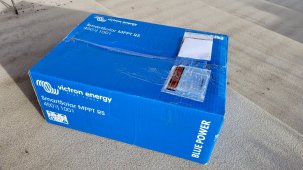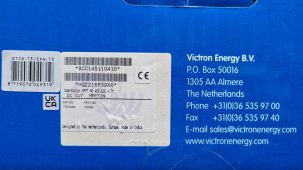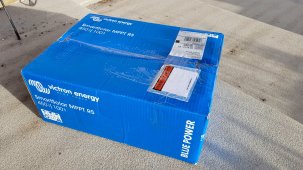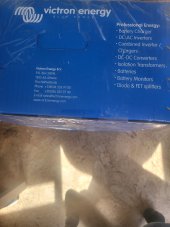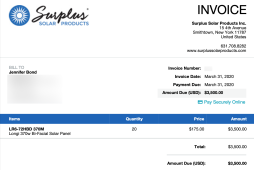You are using an out of date browser. It may not display this or other websites correctly.
You should upgrade or use an alternative browser.
You should upgrade or use an alternative browser.
SOLD Brand new Victron SmartSolar MPPT RS 450/100
- Thread starter barthold
- Start date
sunshine_eggo
Happy Breffast!
DANG! That's less than I paid for my 250/100.
Does it make sense to just get a second 250/100?
Does it make sense to just get a second 250/100?
I will take it. That's exactly what I was looking for. Let me know how you want to proceed with payment and shipping. I'm in AZ.Hi, I have one brand new, never used, never opened, still in original box, Victron Smartsolar MPPT RS 450/100 for sale. Reason I am selling it is because I really needed the bigger 450/200, so now this one is not going to be used. All yours for $850 and I'll pay ground shipping (UPS).
View attachment 129398
View attachment 129395
sunshine_eggo
Happy Breffast!
Wow, great deal, I have the 450/200 and was about to scoop that..... well done Chris (I'm also in AZ).
Me three!
timselectric
If I can do it, you can do it.
- Joined
- Feb 5, 2022
- Messages
- 18,621
I was also thinking about it.
I will take it. That's exactly what I was looking for. Let me know how you want to proceed with payment and shipping. I'm in AZ.
All yours Chris! Sorry everyone else, only have one.
Awsome!! It is also nice to see some fellow Arizonians on this thread.All yours Chris! Sorry everyone else, only have one.
GarySaf
New Member
Hi - I was wondering about the 450/200 vs 450/100 and wanted to see what the reasons for picking to 200 would be over the 100?
Trying to understand the different Victron components better and is it mainly, so you can charge / invert at 200amps?
Or, is it more useful to be able to output mores amps from your solar panels? I was thinking that you'd want to get enough panels in series / parallel to try and get to 450 but keep the amps low so you can use smaller gauge cable.
Also, I don't quite understand why 2 x 450/100's wouldn't be better than 1 x 450/200?
Would really appreciate any insight on what one might pick one or the other option.
Trying to understand the different Victron components better and is it mainly, so you can charge / invert at 200amps?
Or, is it more useful to be able to output mores amps from your solar panels? I was thinking that you'd want to get enough panels in series / parallel to try and get to 450 but keep the amps low so you can use smaller gauge cable.
Also, I don't quite understand why 2 x 450/100's wouldn't be better than 1 x 450/200?
Would really appreciate any insight on what one might pick one or the other option.
sunshine_eggo
Happy Breffast!
Hi - I was wondering about the 450/200 vs 450/100 and wanted to see what the reasons for picking to 200 would be over the 100?
Trying to understand the different Victron components better and is it mainly, so you can charge / invert at 200amps?
Or, is it more useful to be able to output mores amps from your solar panels? I was thinking that you'd want to get enough panels in series / parallel to try and get to 450 but keep the amps low so you can use smaller gauge cable.
Also, I don't quite understand why 2 x 450/100's wouldn't be better than 1 x 450/200?
Would really appreciate any insight on what one might pick one or the other option.
MPPT RS 450/100 or 200 can't inverter at all. They are MPPT only.
Comes down to the practical things - space, cost, weight, # of trackers needed, etc.
OzSolar
Whatever you did, that's what you planned.
Welcome to the madness of solar and tons of component that do maddingly similar things.Hi - I was wondering about the 450/200 vs 450/100 and wanted to see what the reasons for picking to 200 would be over the 100?
Trying to understand the different Victron components better and is it mainly, so you can charge / invert at 200amps?
Or, is it more useful to be able to output mores amps from your solar panels? I was thinking that you'd want to get enough panels in series / parallel to try and get to 450 but keep the amps low so you can use smaller gauge cable.
Also, I don't quite understand why 2 x 450/100's wouldn't be better than 1 x 450/200?
Would really appreciate any insight on what one might pick one or the other option.
To build on what @sunshine_eggo said the 450's are only charge controllers. The 100 is two charge controllers in one box and the 450/200 is four charge controllers. This allows you a lot flexibility when building a system with different lengths of strings, different orientations or even using different modules and getting the most out of them.
450/100 = 100 amp and you can have 2 independent strings. Maximum DC output charging powerHi - I was wondering about the 450/200 vs 450/100 and wanted to see what the reasons for picking to 200 would be over the 100? Also, I don't quite understand why 2 x 450/100's wouldn't be better than 1 x 450/200?
Would really appreciate any insight on what one might pick one or the other option.
4000 W per tracker, 5760 W total.
450-200 = 200 amp and you can have 4 independent strings. Maximum DC output charging power
4000 W per tracker, 11520 W total.
So to answer your question, 2 450/100's would give you 4 strings, a single 450/200 gives you the same amount with less DC cabling, less cost, less install, less VE.can cabling, less weight on your wall (7.9 kg vs 13.7 kg).
The more important thing to ask yourself is if you REALLY need a 450 in either flavor. These are meant for installations of multi panel high voltage arrays, which is what I have and the 250/100 I had just wasn't sufficient. Also the 4 independent trackers allow me to run different panel configurations on the various sides of the garage they're mounted on without impacting each other. The South, SE, SW and flat against the wall facing SE for winter and snow load.
Compared to the other lower string voltage SCC's like the 250/60, the voltage start and operating range of the 450/100 and the 250 are vastly different. The 250 will start tracking from 5v above the battery. The 450 will not do this, again, it is designed for high string voltages. The 450 will only start operating at 120v and can use the range 80v to between 400v and 450v depending on your battery float voltage etc. But the algorithm is also affected by battery voltage. See the tech spec section of the manual. You need a higher string voltage to make the 450 work to it's fullest potential.
Buy once, cry once, trust me, and others here will back up the following statement, "Buy for what you WILL deploy, not for what you ARE deploying now" this is addictive and if you can (with your current system) deal with the need for high string voltage before battery charging starts that the 450's require, they're a GREAT investment for the future.... if not, we look forward to seeing your current SCC in the classifieds section once you realize how cool this is and start ordering pallets of panels. ?
Jen
Last edited:
GarySaf
New Member
Very true - I see now the appeal of things like the Sol Ark 15k, which was what I was leaning toward initially.Welcome to the madness of solar and tons of component that do maddingly similar things.
That is such a great reply - thank you.450/100 = 100 amp and you can have 2 independent strings. Maximum DC output charging power
4000 W per tracker, 5760 W total.
450-200 = 200 amp and you can have 4 independent strings. Maximum DC output charging power
4000 W per tracker, 11520 W total.
So to answer your question, 2 450/100's would give you 4 strings, a single 450/200 gives you the same amount with less DC cabling, less cost, less install, less VE.can cabling, less weight on your wall (7.9 kg vs 13.7 kg).
The more important thing to ask yourself is if you REALLY need a 450 in either flavor. These are meant for installations of multi panel high voltage arrays, which is what I have and the 250/100 I had just wasn't sufficient. Also the 4 independent trackers allow me to run different panel configurations on the various sides of the garage they're mounted on without impacting each other. The South, SE, SW and flat against the wall facing SE for winter and snow load.
Compared to the other lower string voltage SCC's like the 250/60, the voltage start and operating range of the 450/100 and the 250 are vastly different. The 250 will start tracking from 5v above the battery. The 450 will not do this, again, it is designed for high string voltages. The 450 will only start operating at 120v and can use the range 80v to between 400v and 450v depending on your battery float voltage etc. But the algorithm is also affected by battery voltage. See the tech spec section of the manual. You need a higher string voltage to make the 450 work to it's fullest potential.
Buy once, cry once, trust me, and others here will back up the following statement, "Buy for what you WILL deploy, not for what you ARE deploying now" this is addictive and if you can (with your current system) deal with the need for high string voltage before battery charging starts that the 450's require, they're a GREAT investment for the future.... if not, we look forward to seeing your current SCC in the classifieds section once you realize how cool this is and start ordering pallets of panels. ?
Jen
You've explained that so perfectly. While, i'm new to planning solar for my property and been reading quite a bit, this helped really in understanding the charge controllers and specifically the rationale for the 450/200.
My whole project is going to end up being fairly large and for now, I'm working to figure out the sizing and specs to help submit by CA Nem 2 application prior to April (https://diysolarforum.com/threads/solar-design-planning-northern-california.54952/) and then actually complete in the next 2 years.
If you care to read the post above I created last week, you'll see what my initial concerns with the sizing and annual usage were and based on this initial leaning toward the Sol Ark 15k's, but I would need at least 2 ($16,500) and i'm reconsidering the equipment choices now and trying to learn a bit more about Victron.
Thank you so much, that was really a great way to simplify that portion for me.
Thank you for the great response, that makes me feel good that it helped you, so often we help people here and are not really told that it helped or was appreciated, your post warmed my heart.Very true - I see now the appeal of things like the Sol Ark 15k, which was what I was leaning toward initially.
That is such a great reply - thank you.
You've explained that so perfectly. While, i'm new to planning solar for my property and been reading quite a bit, this helped really in understanding the charge controllers and specifically the rationale for the 450/200.
My whole project is going to end up being fairly large and for now, I'm working to figure out the sizing and specs to help submit by CA Nem 2 application prior to April (https://diysolarforum.com/threads/solar-design-planning-northern-california.54952/) and then actually complete in the next 2 years.
If you care to read the post above I created last week, you'll see what my initial concerns with the sizing and annual usage were and based on this initial leaning toward the Sol Ark 15k's, but I would need at least 2 ($16,500) and i'm reconsidering the equipment choices now and trying to learn a bit more about Victron.
Thank you so much, that was really a great way to simplify that portion for me.
That said, you’ll be amazed how easy it is to go higher in voltage without knowing it and than most charge controllers can handle. Panels now are really improving and it doesn’t take many to get over 250v in a string, add on cold weather which can make it even higher and your clipping pretty quickly. If you can manage the investment and make it worth it, it’s a good investment. If not buy a smaller one from a good manufacturer like Victron and you’ll get most of your money back when you sell it, Victron holds their resale value well.
Check out the below Vmax numbers from a couple of my arrays (solar 1, solar 2), (it says 0 watts cus it's night when I grabbed the screen shot), I've had snow on them every day as you can see by the bars above, lots of room for even higher yield yet look how high those max voltages are. That solar 2 is only 4 panels on the roof of a 27' travel trailer, solar 1 is 7 bi facial panels on the roof of a garage and they are optimized direction wise for summer, not winter so terrible alignment to the sun at solar noon.
Jen
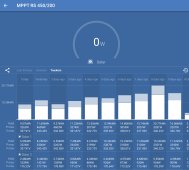
Last edited:
Hedges
I See Electromagnetic Fields!
- Joined
- Mar 28, 2020
- Messages
- 20,690
Also the 4 independent trackers allow me to run different panel configurations on the various sides of the garage they're mounted on without impacting each other.
Now consider paralleling two different strings (or arrays) of very different orientation onto each MPPT input.
So long as they don't get partial shade, impact on output has been shown to be 2% vs. all separate MPPT.
Panels are cheap, mounting hardware not as cheap. But you can get more Wh from same SCC.
OzSolar
Whatever you did, that's what you planned.
I would 2nd this. Higher voltage strings have a lot benefits in my experience.That said, you’ll be amazed how easy it is to go higher in voltage without knowing it and than most charge controllers can handle. Panels now are really improving and it doesn’t take many to get over 250v in a string,
Similar threads
- Replies
- 3
- Views
- 281
- Replies
- 23
- Views
- 719
- Replies
- 22
- Views
- 879
- Replies
- 6
- Views
- 819



